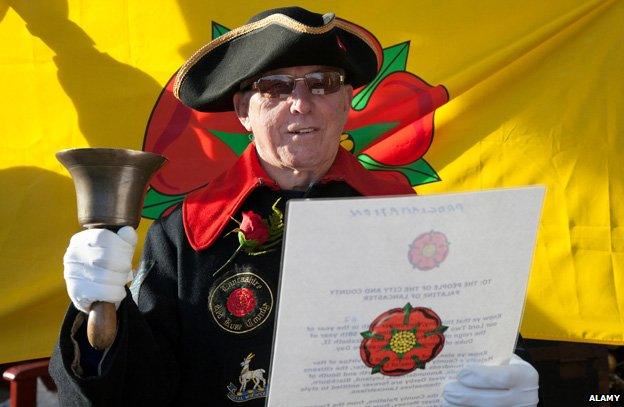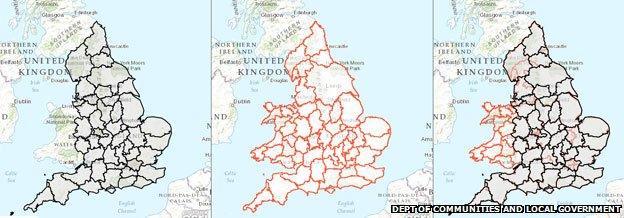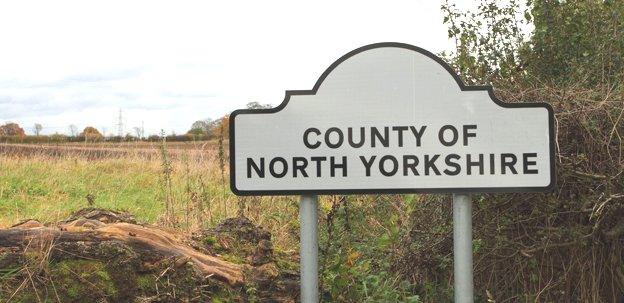The baffling map of England's counties
- Published

Signs marking traditional English county boundaries are due to return, but the distinction between historic and administrative divisions can be hugely confusing.
Do you know which county you live in? Are you sure? Is that a historic or a ceremonial council or a county council or some combination thereof?
Many people's sense of self is bound up in a fierce local pride about their county. But it isn't always clear exactly which is the relevant one.
People in Scunthorpe lived in the non-metropolitan and ceremonial county of Humberside from 1974 to 1996. Now they live in the ceremonial county of Lincolnshire and the unitary authority of North Lincolnshire. Humberside no longer exists as a county but Humberside Police and Humberside Fire and Rescue Service still do.
If you're in Birkenhead, you are in the historic county of Cheshire, the ceremonial county of Merseyside (although Merseyside County Council was abolished in 1986) and the Metropolitan Borough of Wirral.

Maps showing how ceremonial (left) and historic (centre) counties overlap (right)
Middlesex dates back to the 8th Century but Middlesex County Council was abolished in 1965. Middlesex County Cricket Club and Middlesex University live on. So too does the historic county of Middlesex even though most of its inhabitants now live in the ceremonial county of Greater London.
Still following?
England's counties are the source of much regional pride, not least on cricket pavilions. To identify as a Yorkshirewoman or a Devonian or a Northumbrian is to invite certain expectations about the forthrightness of one's views or one's tolerance for cider and clog-dancing.

But successive waves of local government reform have left many people deeply unclear as to which county they live in - the answer to which depends on exactly what you mean by the word "county".
Now, in an effort to support the "tapestry" of ancient place names, the government has changed its rules allowing councils to put up boundary signs marking traditional English counties - including the likes of Cumberland and Huntingdonshire, names which no longer have any connection to county-wide local authorities.
"Previous governments have tried to wipe the counties off the map, imposing bland administrative structures or alien euro-regions," Communities Secretary Eric Pickles said as he announced the change. But "we are stronger as a nation when we cherish and champion our local and traditional ties", he added.
The move has been welcomed by the Association of British Counties (ABC), which promotes awareness of the UK's 92 historic counties. It's unlikely, however, to clear up what the ABC calls "county confusion", external. There are, in fact, three types of counties in England. Counties of different variety may share the same names as each other but not necessarily the same borders.
First there are the historic counties, which date as far back as the mid-Saxon period. Some, like Westmorland, no longer exist in an administrative sense. But especially in places like Yorkshire, Durham and Cornwall, they are important expressions of geographic and cultural identity.
Then there are administrative counties and unitary authority areas created by the 1972 Local Government Act. These include non-metropolitan county councils like Oxfordshire and Surrey (where some services are also provided by districts). Others, like Northumberland, are single-tier unitary councils. Some areas like Berkshire have no county council and the districts are the sole local authorities.

And finally there are the ceremonial counties, established by the 1997 Lieutenancies Act, each of which has a Lord Lieutenant. Bedfordshire and Cheshire, for instance, do not exist as councils but do as ceremonial counties. In metropolitan counties like Merseyside, Tyne and Wear and Greater Manchester, county councils were scrapped in the 1980s, but some services including transport and the police are run jointly by groups of councillors within the old boundaries.
If you've followed that, well done. Catherine Staite, director of the Institute of Local Government at Birmingham University, says there was no consistency to the way these overlapping boundaries were drawn. "We've ended up with a patchwork of arrangements for which there is no logic."
So, for instance, Barrow-In-Furness belongs to the historic county of Lancashire. Its ceremonial county is Cumbria. It is governed by Cumbria County Council, which also covers the historic counties of Cumberland and Westmorland.
Then there is Saddleworth, formerly of the West Riding of Yorkshire and now of the Metropolitan Borough of Oldham and the ceremonial county of Greater Manchester. Many of its inhabitants still proudly fly the white rose flag.
In an effort to clear up the confusion - and, it says, champion England's local identities - the government is publishing an online interactive map of county boundaries, external and how they overlap.
The situation is less confusing in Scotland and Wales, where local government is single tier, though some councils like Clackmannanshire and Fife do correspond to historic counties. In Northern Ireland, which has 26 district councils, inhabitants of counties Armagh, Antrim and Fermanagh will identify themselves as such.
According to Andy Strangeway, a campaigner for greater recognition of England's counties,, external more of the historic East Riding of Yorkshire is outside the current East Riding of Yorkshire unitary council area than within it. This, he says, amounts to "cultural vandalism". Counties have been neglected, he believes, because they matter more to those who don't belong to the metropolitan elite.
"The further you get away from the M25, the more important counties become," he says. "It's in places like Yorkshire, Cornwall and Durham that they matter most."
There have been setbacks for supporters of the counties. In 2010, the Royal Mail deleted county names from its Postcode Address File database, which lists every address in the UK.
But the movement for greater recognition of these historic boundaries has reason to feel confident that its cause is on the march. Rutland, constituted as a district of Leicestershire in 1974, was re-established as a county in its own right in 1997. Cricket teams and BBC local radio stations all keep the names of counties alive.
Some, including Staite, are sceptical about the wisdom of how far this can be taken. "Are you going to go back to the Wapentakes?" she says.
But Strangeway says the counties will linger on in the popular imagination regardless. "No-one is loyal to the people who empty their bins - they'll be here today and gone tomorrow," he says. "The counties are part of our cultural heritage."
Perhaps it doesn't matter if you can't make sense of them at all.
Follow @BBCNewsMagazine, external on Twitter and on Facebook, external